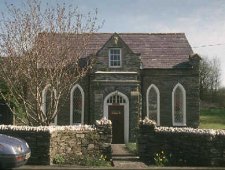
Born 1810,Overton, Flintshire; came to the Island in 1830 as assistant to his brother Edward Welch who was partner of Joseph Aloysius Hansom. It was this later partnership, after many successes in North Wales and Northern England who were invited to design King Williams College; shortly afterwards however this partnership was bankrupted by problems during the building of Birmingham Town Hall. Although John was probably involved, he escaped bankruptcy.
Edward Welch left the Island before the completion of King William's College and John Welch claimed to have altered the design of the tower. (Note the design was again changed during the rebuilding after the 1844 fire - see photo for a 1920's view).
Manx Advertiser 18 Nov 1834 (+ subsequent issues) carried the following advertisement
John Welch Architect Begs respectfully to inform the Public that he has prepared a number of designs for Cottages, Villas &c in a variety of styles to which he has endeavored to combine Economy of Arrangement and Design with a degree of Taste and Appearance
To the Gentlemen who would so honour him by a call they are open for inspection at his office, Athol Court, every day from 10 to 4
In 1836 he had an address on North Quay and advertised his services as 'architect, civil engineer and general surveyor'. Entered into partnership with John Moore, a builders' merchant which went into bankruptcy in 1837 (a letter in Manx Liberal 19 Dec 1840 complained re non-payment of debts 'It is now 3 years since the firm of Welch and Moore was dissolved and the latter been insolvent...').
A brief notice in Manx Liberal 4 Feb 1837 read:
Mr Welch architect, Douglas...plans for a new town hall and Market in the town of Flint have been adopted by the burgesses and ordered to be carried into execution.
Island commissions however did not come his way - for although we read in Manx Liberal 1 April 1837
We understand that his Excellency the Lieutenant Governor has instructed Mr Welch, architect, to prepare plans and estimates for effecting necessary repairs and alterations to the Rolls Offices at Castletown
the job went to Thomas Brine instead.
Welch had migrated to North Wales by 1838 and worked in St Asaph in 1839 before later moving to Preston (c.1844) where he died.
An advertisement in Manx Liberal, repeated for some months from 16 Jun 1838, gave Mssrs Welch and Webbe, architects with offices Old Bank Douglas (next door from Mssrs Quiggin Timber Yard). The text reads:
Mssrs Welch and Webbe return their grateful acknowledgments to the Inhabitants of Douglas and the Island in general for their liberal support they have been honoured with and hope by strict punctuality to Business to insure a continuation of their Favors.
Mr Welch visits the Island alternately as usual and Mr Webbe (resident architect) continues the Profession offering unequaled advantages to persons having property on the Island and only residing on the Island a short period of the season here, especially when Buildings and other Improvements are required as Plans, Specifications and Estimates of the Costs may be had on the shortest notice and a regular correspondence where required on the lowest possible remuneration.
Undeniable security can be given if required
The only Webbe I can find is J. Webbe, PianoForte,singing etc. teacher (Finch Road) in Cannell's 1843 directory, cannot find in the 1841 census.
Other buildings John Welch was connected with include:
House of Industry, Douglas.
Like KWC since altered and extended.
The Scotch Kirk in
Douglas - again altered and later demolished.
The Tower of Refuge 1832
to a commission by Sir William Hillary
and the Smelt Memorial
at Castletown.
the Hermitage, 1833, Peel Road (now demolished).
He was also involved in the conversion of Castle Mona into a hotel
However most of Welch's buildings are the churches commissioned by Bishop Ward between 1830 and 1840
 |
He is also supposed to have designed the Sunday School in Onchan, built c.1842. |
Other possible work includes two buildings in Finch Road; was also agent for Fort William.
He is also credited with the authorship of A Six Days Tour supposedly by A Stranger published on 1st April 1836. The date of publication may give some indication of the sharp barbed criticism found within it.
A Biographical Dictionary of British Architects, 1600-1840 3rd Ed, H. Colvin; Yale University Press 1995
|
|
||
|
Any comments, errors or omissions
gratefully received The
Editor |
||